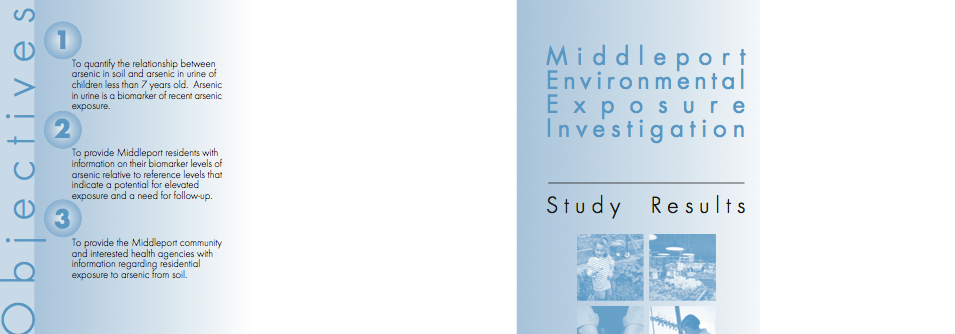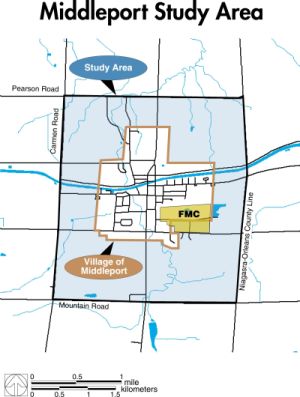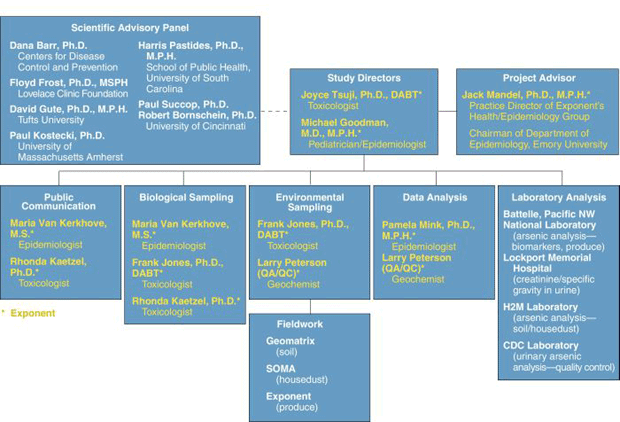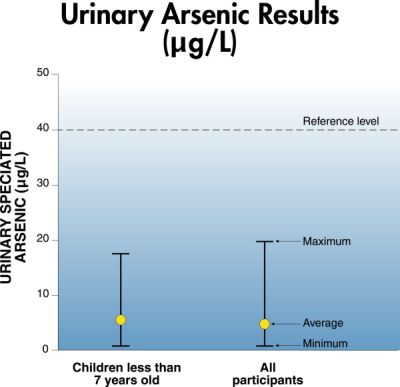
Environmental Initiatives / Studies
Middleport Environmental Exposure Investigation Study Results – 2004
Conducted in summer 2003, the Middle Environmental Exposure Investigation was designed to meet three main study objectives:
- To quantify the relationship between arsenic in soil and arsenic in urine of children less than 7 years old. Arsenic in urine is a biomarker of recent arsenic exposure.
- To provide Middleport residents with information on their biomarker levels of arsenic relative to reference levels that indicate a potential for elevated exposure and a need for follow-up.
- To provide the Middleport community and interested health agencies with information regarding residential exposure to arsenic from soil.
The findings indicate that the levels of arsenic observed in this investigation are not expected to cause health problems. The final report, appendices to the report, and a summary brochure are available as PDF files:
Questions and Answers
What is the nature of arsenic and how is it used?
Arsenic is a natural element that is widely distributed in the earth’s crust. Two main forms of arsenic are inorganic arsenic and organic arsenic. Organic forms such as in food are usually less harmful than the inorganic forms. Inorganic arsenic occurs naturally in water, soil and many kinds of rock, especially in minerals and ores that contain copper or lead.
Everyone is exposed to small amounts of arsenic through the air we breathe, the water we drink, and the food we eat. Of these, food is usually the largest source of arsenic. Fish and seafood contain the greatest amounts of arsenic, but this arsenic is mostly in the organic form, the form least harmful. Young children are likely to eat small amounts of dust or dirt each day, which is another way they may be exposed to arsenic. The body absorbs arsenic in water more efficiently than arsenic in soil.
If you are exposed to arsenic, many factors determine whether you will be harmed. These factors include the dose (how much), the duration (how long), and the frequency (how often), the form of arsenic and how you come in contact with it. Other factors may include your age sex, diet, family traits, lifestyle, and state of health.
What was the biomonitoring study about?
Biomonitoring refers to testing a population for clinical measure of possible exposure to a particular substance, in this case arsenic. This study investigated whether residents of the Middleport community have been exposed to excess levels of arsenic from soil.
The study focused on levels of urinary speciated arsenic, a measure of exposure to inorganic arsenic from soil. Study investigators compared speciated arsenic levels in urine to arsenic levels in soil, house dust, and homegrown produce. Careful attention was given to other exposure factors such as diet, individual activities (such as playing in creeks), and other potential sources of arsenic.
Who participated in the study?
Young children less than age 7 were the primary focus of the study because of their greater potential for soil exposure. Seventy-seven young children or nearly half the available population in this age group within the study area participated (Figure 1). A total of 362 older children and adults also participated.

Figure 1. Study Area of the Middleport Environmental Exposure Investigation
Why was this study conducted?
The community advisory panel (CAP) of Middleport asked FMC to conduct a biomonitoring study of the Middleport Community.
Who paid for the project?
 Figure 2. Organization Chart of the Study Team
Figure 2. Organization Chart of the Study Team What samples were collected?
Participants were asked to provide urine samples collected in the morning on two consecutive days. Toenail samples were collected and analyzed for arsenic only upon request. Professional field staff collected soil and interior house dust samples from participating residential properties that had owner consent. Homegrown produce was sampled at the request of homeowners.
Where were the samples analyzed?
Samples were shipped to federally accredited laboratories, including the CDC, where they were measured for arsenic levels.
What did the study find?
 Figure 3. Urinary Speciated Arsenic in Children Less Than 7 Years Old and in All Participants
Figure 3. Urinary Speciated Arsenic in Children Less Than 7 Years Old and in All Participants
- Urinary arsenic levels of individual participants were overall much lower than the reference level for elevated arsenic exposure. Toenail arsenic levels were also below the CDC reference level for normal exposure.
- There was no evidence that exposure to arsenic in soil or house dust increased speciated arsenic in urine in children less than 7 years old. Expanding the analysis to include older ages had the same result.
- Eating garden vegetables, playing in creeks, or other soil-related behaviors were not associated with increased urinary arsenic levels.
- Sources of inorganic arsenic other than soil (likely background levels in water and diet) are the primary contributors to inorganic arsenic exposure in this community.



